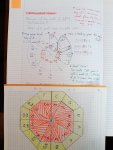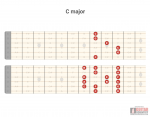NEW HOMEWORK: Lesson 10 And Tutorials!
- General Chat
- 59 Replies
Ooookaaayyy…
First off, BIG thanks to Calvin for trying to do this in my absence and Hector for taking over the live feed. You both are extremely wonderful. I’m a little confused as to why no one did Calvin’s task but regardless if it’s me or someone else who decides to issue a homework challenge, we should all show support and jump on the bandwagon.
I’ll try…
Lesson 10 is very important to grasp the basic concepts of soloing over chords so here it goes.
Beginners: Find a three chord progression and demonstrate what your “6 Magic Notes” would be over those chords. Be sure to name the chord AND the corresponding notes.
Intermediate: Write a riff using the 6 magic notes over a chord progression of your choice. For example, if you were to do a basic jazz ii-V-I progression, choose a backing track that features this progression in your key signature and perform that riff each time the chords change.
Advanced: Compose your own Etude using ONLY the six magic notes a straight backing track. For example, don’t do something where the chords change every other count. Something a little more straightforward. Think “Betcha Can’t Play This” column in the guitar magazine.
++++++++++++++ALSO!!!++++++++++++++++
If you post your work here and want access to the tutorials I’ve done, let me know! As I stated on my Instagram my tutorial work is strictly for those who are active with the lessons here. It’s my way of saying “Great job, you earned it” to those who put so much work into their craft.
Tutorial List
1. Scream
2. Shepherd of Fire
3. Nightmare
4. Hail To The King
5. Buried Alive
They are not ALL completed yet. But I’m working on getting them all finished.
PLUS!
Please join me THIS SATURDAY, FEBRUARY 16th at 3pm CST to demonstrate your homework, welcome a new student, AND I’ll be having a guitar talk with Rowan and discussing her guitar insight and some valuable points we both share about guitar and beginners. Only those who have performed the homework or want to show off what they learned in a LESSON will be permitted to go live.
Love you all! We track bass and vocals next in the studio!
Jak
First off, BIG thanks to Calvin for trying to do this in my absence and Hector for taking over the live feed. You both are extremely wonderful. I’m a little confused as to why no one did Calvin’s task but regardless if it’s me or someone else who decides to issue a homework challenge, we should all show support and jump on the bandwagon.
I’ll try…
Lesson 10 is very important to grasp the basic concepts of soloing over chords so here it goes.
Beginners: Find a three chord progression and demonstrate what your “6 Magic Notes” would be over those chords. Be sure to name the chord AND the corresponding notes.
Intermediate: Write a riff using the 6 magic notes over a chord progression of your choice. For example, if you were to do a basic jazz ii-V-I progression, choose a backing track that features this progression in your key signature and perform that riff each time the chords change.
Advanced: Compose your own Etude using ONLY the six magic notes a straight backing track. For example, don’t do something where the chords change every other count. Something a little more straightforward. Think “Betcha Can’t Play This” column in the guitar magazine.
++++++++++++++ALSO!!!++++++++++++++++
If you post your work here and want access to the tutorials I’ve done, let me know! As I stated on my Instagram my tutorial work is strictly for those who are active with the lessons here. It’s my way of saying “Great job, you earned it” to those who put so much work into their craft.
Tutorial List
1. Scream
2. Shepherd of Fire
3. Nightmare
4. Hail To The King
5. Buried Alive
They are not ALL completed yet. But I’m working on getting them all finished.
PLUS!
Please join me THIS SATURDAY, FEBRUARY 16th at 3pm CST to demonstrate your homework, welcome a new student, AND I’ll be having a guitar talk with Rowan and discussing her guitar insight and some valuable points we both share about guitar and beginners. Only those who have performed the homework or want to show off what they learned in a LESSON will be permitted to go live.
Love you all! We track bass and vocals next in the studio!
Jak



